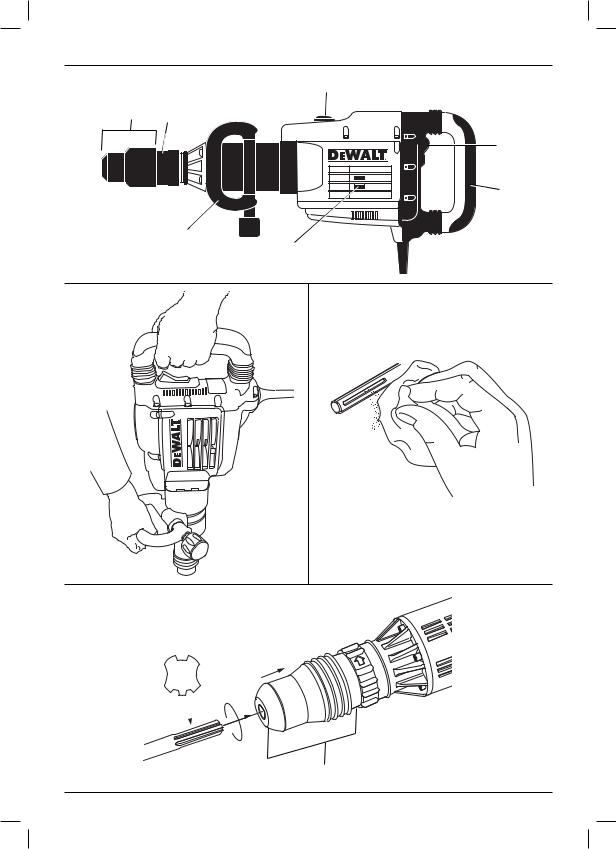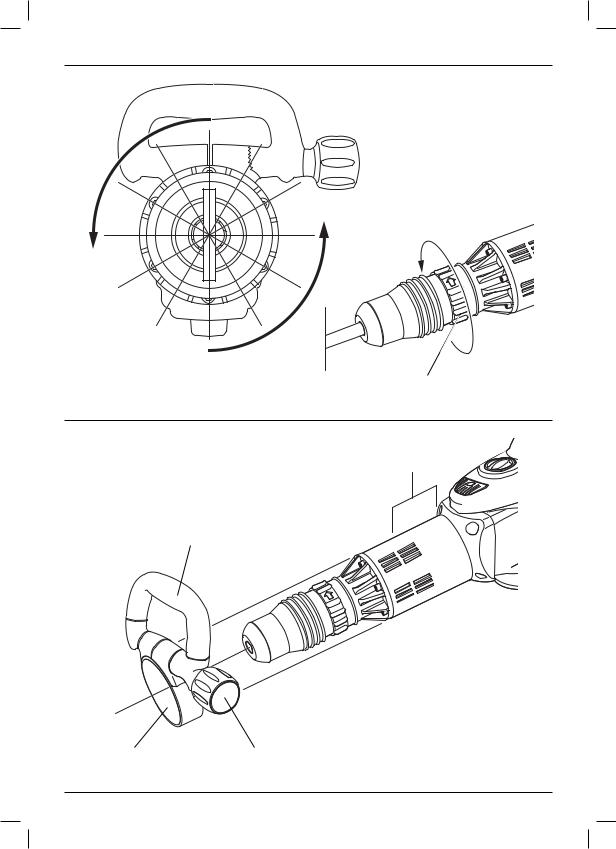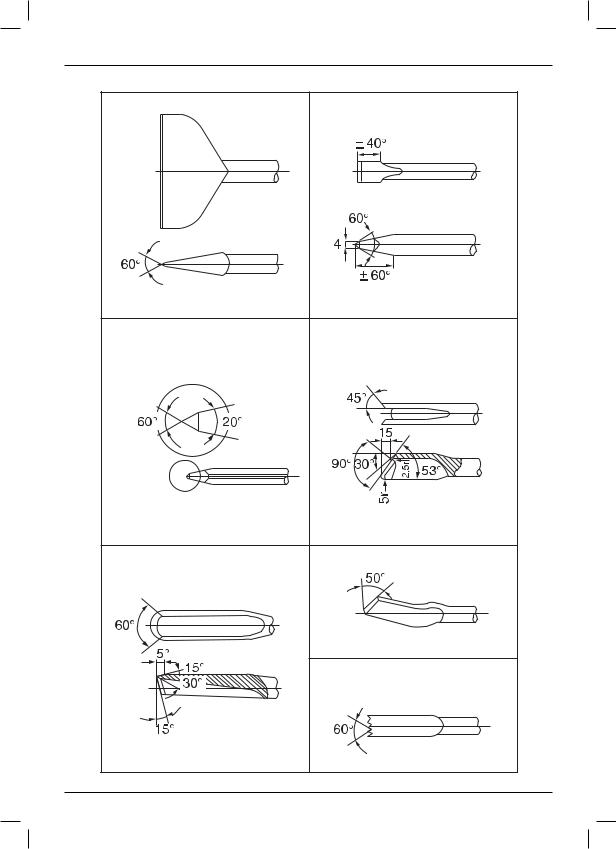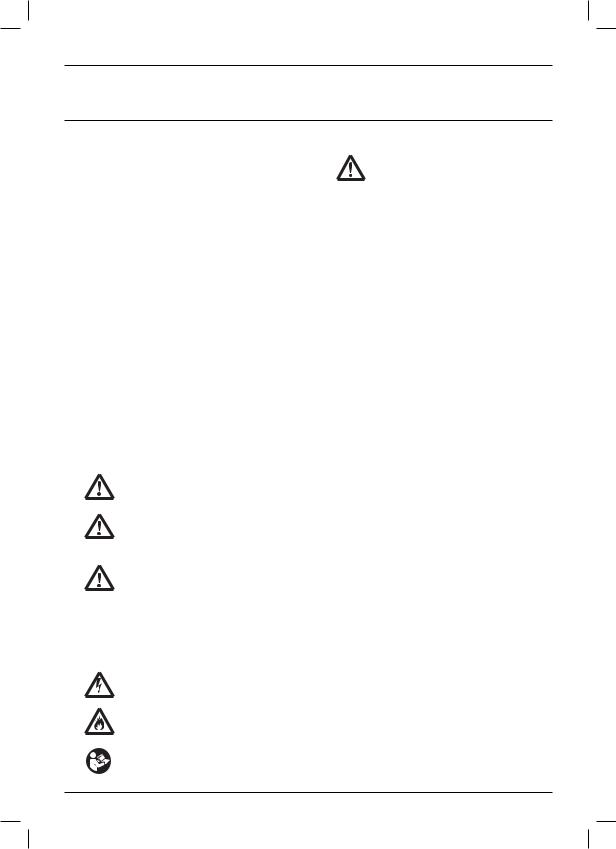DeWalt D25901 User Manual

D25901

English (original instructions) |
4 |
Français (traduction de la notice d’instructions originale) |
10 |
ﺍﻝﻉﺭﺏﻱﺓ (ﻡﺕﺭﺝﻡ ﻉﻥ ﺍﻝﺕﻉﻝﻱﻡﺍﺕ ﺍﻝﺃﺹﻝﻱﺓ) |
17 |
Copyright DEWALT
2

Figure 1 |
c |
|
1 ﻞﻜﺷ |
||
|
||
e |
d |
a
b
|
f |
|
g |
Figure 2 |
Figure 3 |
2 ﻞﻜﺷ |
3 ﻞﻜﺷ |
Figure 4
4 ﻞﻜﺷ
e
1

Figure 5
5 ﻞﻜﺷ
d
Figure 6
6 ﻞﻜﺷ
x
f
h |
i |
2

Figure 7 / ﺵﻙﻝ 7 |
|
j |
k |
l |
m |
n |
o |
|
p |
3

ENGLISH
DEMOLITION HAMMER
D25901
Congratulations! |
General Power Tool Safety Warnings |
You have chosen a DEWALT tool. Years of experience, thorough product development and innovation make DEWALT one of the most reliable partners for professional power tool users.
Technical Data
|
|
D25901 |
|
|
|
Voltage |
V |
220–240 |
|
|
120 |
Type |
|
2 |
Frequency |
Hz |
50/60 |
Power input |
W |
1,550 |
Impact rate |
min-1 |
1,050–2,100 |
Impact energy (EPTA 05/2009) |
J |
19 |
Tool holder |
|
SDS Max® |
Chisel positions |
|
12 |
Weight |
kg |
10.5 |
Definitions: Safety Guidelines
The definitions below describe the level of severity for each signal word. Please read the manual and pay attention to these symbols.
DANGER: Indicates an imminently hazardous situation which, if not avoided, will result in death or serious injury.
WARNING: Indicates a potentially hazardous situation which, if not avoided, could result in death or serious injury.
CAUTION: Indicates a potentially hazardous situation which, if not avoided, may result in minor or moderate injury.
NOTICE: Indicates a practice not related to personal injury which, if not avoided, may result in property damage.
Denotes risk of electric shock.
Denotes risk of fire.
WARNING: To reduce the risk of injury, read the instruction manual.
WARNING! Read all safety warnings and all instructions. Failure to follow the warnings and instructions may result in electric shock, fire and/or serious injury.
SAVE ALL WARNINGS AND INSTRUCTIONS
FOR FUTURE REFERENCE
The term “power tool” in the warnings refers to your mains-operated (corded) power tool or batteryoperated (cordless) power tool.
1)WORK AREA SAFETY
a)Keep work area clean and well lit.
Cluttered or dark areas invite accidents.
b)Do not operate power tools in explosive atmospheres, such as in the presence of flammable liquids, gases or dust. Power tools create sparks which may ignite the dust or fumes.
c)Keep children and bystanders away while operating a power tool. Distractions can cause you to lose control.
2)ELECTRICAL SAFETY
a)Power tool plugs must match the outlet. Never modify the plug in any way. Do not use any adapter plugs with earthed (grounded) power tools. Unmodified plugs and matching outlets will reduce risk of electric shock.
b)Avoid body contact with earthed or grounded surfaces such as pipes, radiators, ranges and refrigerators. There is an increased risk of electric shock if your body is earthed or grounded.
c)Do not expose power tools to rain or wet conditions. Water entering a power tool will increase the risk of electric shock.
d)Do not abuse the cord. Never use the cord for carrying, pulling or unplugging the power tool. Keep cord away from heat, oil, sharp edges or moving parts.
Damaged or entangled cords increase the risk of electric shock.
e)When operating a power tool outdoors, use an extension cord suitable for outdoor use. Use of a cord suitable for outdoor use reduces the risk of electric shock.
f)If operating a power tool in a damp location is unavoidable, use a residual current device (RCD) protected supply.
4

ENGLISH
Use of an RCD reduces the risk of electric shock.
3)PERSONAL SAFETY
a)Stay alert, watch what you are doing and use common sense when operating a power tool. Do not use a power tool while you are tired or under the influence of drugs, alcohol or medication. A moment of inattention while operating power tools may result in serious personal injury.
b)Use personal protective equipment. Always wear eye protection. Protective equipment such as dust mask, non-skid safety shoes, hard hat, or hearing protection used for appropriate conditions will reduce personal injuries.
c)Prevent unintentional starting. Ensure the switch is in the off position before connecting to power source and/or battery pack, picking up or carrying the tool. Carrying power tools with your finger on the switch or energising power tools that have the switch on invites accidents.
d)Remove any adjusting key or wrench before turning the power tool on. A wrench or a key left attached to a rotating part of the power tool may result in personal injury.
e)Do not overreach. Keep proper footing and balance at all times. This enables better control of the power tool in unexpected situations.
f)Dress properly. Do not wear loose clothing or jewellery. Keep your hair, clothing and gloves away from moving parts. Loose clothes, jewellery or long hair can be caught in moving parts.
g)If devices are provided for the connection of dust extraction and collection facilities, ensure these are connected and properly used. Use of dust collection can reduce dust-related hazards.
4)POWER TOOL USE AND CARE
a)Do not force the power tool. Use the correct power tool for your application.
The correct power tool will do the job better and safer at the rate for which it was designed.
b)Do not use the power tool if the switch does not turn it on and off. Any power tool that cannot be controlled with the switch is dangerous and must be repaired.
c)Disconnect the plug from the power source and/or the battery pack from the power tool before making any adjustments, changing accessories, or
storing power tools. Such preventive safety measures reduce the risk of starting the power tool accidentally.
d)Store idle power tools out of the reach of children and do not allow persons unfamiliar with the power tool or these instructions to operate the power tool.
Power tools are dangerous in the hands of untrained users.
e)Maintain power tools. Check for misalignment or binding of moving parts, breakage of parts and any other condition that may affect the power tool’s operation. If damaged, have the power tool repaired before use. Many accidents are caused by poorly maintained power tools.
f)Keep cutting tools sharp and clean.
Properly maintained cutting tools with sharp cutting edges are less likely to bind and are easier to control.
g)Use the power tool, accessories and tool bits etc., in accordance with these instructions taking into account the working conditions and the work to be performed. Use of the power tool for operations different from those intended could result in a hazardous situation.
5)SERVICE
a)Have your power tool serviced by a qualified repair person using only identical replacement parts. This will ensure that the safety of the power tool is maintained.
Additional Safety Instructions for Demolition Hammers
•Wear ear protectors. Exposure to noise can cause hearing loss.
•Use auxiliary handles supplied with the tool.
Loss of control can cause personal injury.
•Hold power tools by insulated gripping surfaces when performing an operation where the cutting tool may contact hidden wiring or its own cord. Cutting accessory Contacting a “live” wire may make exposed metal parts of the tool “live” and shock the operator.
•Be certain that the material being drilled does not conceal electric or gas service and that their locations have been verified with the utility companies.
•Keep a firm grip on the tool at all times. Do not attempt to operate this tool without holding it with both hands. Operating this tool with one hand will result in loss of control. Breaking
5

ENGLISH
through or encountering hard materials such as re-bar may be hazardous as well. Tighten the side handle securely before use.
•Ensure the chisel is secured in place before operating the tool.
•In cold-weather conditions or when the tool has not been used for a longer period of time, let the tool run with no load for several minutes before use.
•When working above ground level ensure the area below is clear.
•Do not touch the chisel or the parts close to the chisel immediately after operation, as they may be extremely hot and cause burns to the skin.
•Always direct the power cable to the rear, away from the chisel.
•Do not operate this tool for long periods of time. Vibration caused by hammer action may be harmful to your hands and arms. Use gloves to provide extra cushion and limit exposure by taking frequent rest periods.
Residual Risks
The following risks are inherent to the use of demolition hammers:
–Injuries caused by touching the hot parts of the tool.
In spite of the application of the relevant safety regulations and the implementation of safety devices, certain residual risks cannot be avoided. These are:
–Impairment of hearing.
–Risk of squeezing fingers when changing the accessory.
–Health hazards caused by breathing dust developed when working in concrete and/or masonry.
Markings on Tool
The following pictograms are shown on the tool:
Read instruction manual before use.
Wear ear protection.
Wear eye protection.
DATE CODE POSITION (FIG. 1)
The date code (g), which also includes the year of manufacture, is printed into the housing.
Example:
2013 XX XX
Year of Manufacture
Package Contents
The package contains:
1Demolition hammer
1Side handle
1Pointed chisel
1Plastic case
1Instruction manual
1Exploded drawing
•Check for damage to the tool, parts or accessories which may have occurred during transport.
•Take the time to thoroughly read and understand this manual prior to operation.
Description (fig. 1)
WARNING: Never modify the power tool or any part of it. Damage or personal injury could result.
a.On/off switch
b.Main handle
c.Electronic impact energy control dial
d.Chisel position index collar
e.Tool holder/sleeve
f.Side handle
INTENDED USE
The D25901 heavy-duty demolition hammer is designed for heavy-duty demolition, chipping and chasing applications.
DO NOT use under wet conditions or in presence of flammable liquids or gases.
These heavy-duty demolition hammers are professional power tools. DO NOT let children come into contact with the tool. Supervision is required when inexperienced operators use this tool.
•This product is not intended for use by persons (including children) suffering from diminished physical, sensory or mental abilities; lack of experience, knowledge or skills unless they are supervised by a person responsible for their safety. Children should never be left alone with this product.
6

ENGLISH
Soft Start Feature
The soft start feature allows the impact rate to build up more slowly, thus preventing the chisel or point from “bouncing” around on the masonry when starting up.
Active Vibration Control
The active vibration control neutralises rebound vibration from the hammer mechanism. Lowering hand and arm vibration, it allows more comfortable use for longer periods of time and extends the life of the unit.
Electronic Impact Energy Control (fig. 1)
The electronic impact energy control (c) offers the following advantages:
•use of smaller accessories without risk of breakage
•minimised break-out when chiselling soft or brittle materials
•optimal tool control for precise chiselling
Electrical Safety
The electric motor has been designed for one voltage only. Always check that the power supply corresponds to the voltage on the rating plate.
Your DEWALT tool is double insulated in accordance with EN 60745; therefore no earth wire is required.
WARNING: 120 V units have to be operated via a fail-safe isolating transformer with an earth screen
between the primary and secondary winding.
If the supply cord is damaged, it must be replaced by a specially prepared cord available through the DEWALT service organisation.
Mains Plug Replacement
(Middle East and Africa)
If a new mains plug needs to be fitted:
•Safely dispose of the old plug.
•Connect the brown lead to the live terminal in the plug.
•Connect the blue lead to the neutral terminal.
WARNING: No connection is to be made to the earth terminal.
Follow the fitting instructions supplied with good quality plugs. Recommended fuse: 13 A.
Using an Extension Cable
If an extension cable is required, use an approved extension cable suitable for the power input of this tool (see Technical Data). The minimum conductor size is 1 mm2; the maximum length is 30 m.
When using a cable reel, always unwind the cable completely.
ASSEMBLY AND ADJUSTMENTS
WARNING: To reduce the risk of injury, turn unit off and disconnect machine from power source before installing and removing accessories, before adjusting or changing setups or when making repairs. Be sure the trigger switch is in the OFF position. An accidental start-up can cause injury.
WARNING: Always wear gloves when changing accessories. The exposed metal parts on the tool and accessory may become extremly hot during operation.
Inserting and Removing SDS Max®
Accessories (fig. 3, 4)
This machine uses SDS Max® chisels (refer to the inset in Figure 4 for a cross-section of a chisel shank).
Only DEWALT recommended accessories should be used with this product.
1. Clean the chisel shank.
WARNING: Do not apply lubricant to the machine.
2.Insert the chisel shank into the tool holder/ sleeve (e). Press and turn the chisel slightly until the sleeve snaps into position.
3.Pull on the chisel to check if it is properly locked. The hammering function requires the chisel to be able to move axially several centimetres when locked in the tool holder.
4.To remove a chisel, pull back the tool holder/ sleeve (e) and pull the chisel out of the tool holder.
Indexing the Chisel Position (fig. 5)
The chisel can be indexed and locked into 12 different positions.
7
